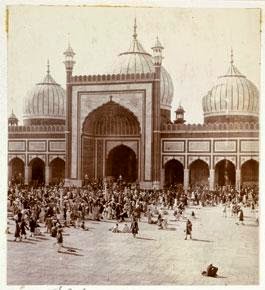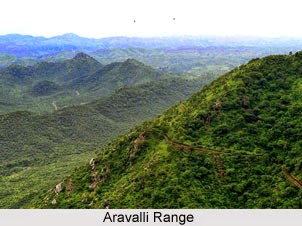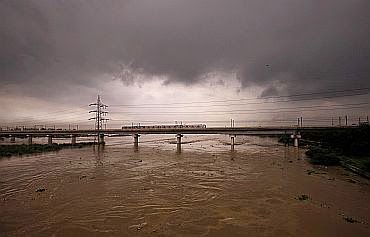British East India Company signaled the end of Purani Dilli…..For over 200 years the Red Fort and neighbouring areas housed both
Mughal nobility and ordinary citizens…..The capture of Delhi in 1858 led to Shahjahanabad being changed forever…..city was torn apart by the British….Muslims were hounded out….their properties looted and destroyed…..
……
…….
From the (mythical???) all-glass capital of Indraprastha (Pandavas, Mahabharata) to the modern times and modern-day New Delhi, the valley marked by the Yamuna river to the east and the Aravalli hills to the West and South-West has been privileged as the seat of political power in India.
…..
…
Take any train that terminates in the old (original) Delhi station (for example, Mussorie Express from the eponymous Hill Station) and at journey’s end you cross the river and trundle past the magnificent Red Fort. You will not easily forget the experience (we promise).
….
….
Shah-Jahan-abad is being gentrified one public toilet at a time. We would not really recommend shopping in Chandni Chowk. Try Pahar-Gunj instead, for cheap hotels and cheap finery, a brief walk from the New Delhi Railway terminus (modern one). The Delhi Metro is a wonderful thing, so you can get lodgings in posh Ramakrishna Puram (RK Puram) or Vasant Vihar and still manage to catch the sights, sounds (and most importantly flavors) of the old city. But remember what the old lady had warned about- please be home by night-fall.
…….
After over seven years of bureaucratic apathy, confusion,
indifference and lack of long-term planning to revive the once Mughal
capital, work on the redevelopment of Shahjahanabad has begun.
The name ‘Shahjahanabad’— the place itself laid out by the Mughal
Emperor in the middle of the seventeenth century—might conjure romantic
images of a bygone era, but the reality is far more cruel. A walk down
Chandni Chowk makes this no easier to accept. Except for tourists, both
foreign and domestic, most of those in New Delhi look down upon Old
Delhi as a crowded and noisy place that is best avoided.
Their lack of
an emotional connection with a part of the city that was for over 200
years the actual capital can be blamed on the fact that successive
governments of independent India have looked at Shahjahanabad the same
way it was viewed by the British colonial government.
…
From the Red Fort, one has to cross the busy Netaji Subhas Marg
towards Gauri Shankar Mandir; hopping over piles of garbage and pools of
urine that have leaked out of broken public urinals and onto the uneven
and broken pavements that have long since given way under pressure of
encroachments and temporary stalls selling everything from unbranded
inner-wear to footwear and flowers. One has to negotiate one’s way while
getting elbowed by eager buyers, pushcarts and rickshaws, with motor
cars honking wildly to get past the chaos and confusion under the
decaying facades of Mughal-time and Art-Deco structures made uglier by
the hoardings and billboards of umpteen commercial outlets.
…
In 1911, King George V announced that the capital of British India
was to be shifted away from Calcutta, at an extravagant Delhi Durbar
held in what is now Coronation Park next to Nirankari Sarovar in north
Delhi.
The monarch had desired that a new capital—called New Delhi— be
built, one that would be contiguous with the Mughal city of
Shahjahanabad. His wish, however, was never fulfilled as the team of
architects found the area in north Delhi marshy and full of swamps. They
instead suggested that the area around Raisina and Malcha be developed
into the new capital.
But, even as New Delhi arose in the 1930s, Shahjahanabad remained the
main shopping area for Indians living in the city, while the upcoming
Connaught Place would have stores selling imported food and wines to
English administrators. New Delhi looked antiseptic and devoid of colour
and life.
My mother, now in her mid eighties, recalls visiting Chandni
Chowk with her own mother in the early 1940s, travelling from Pusa
(where her father was heading the Imperial Agriculture Research
Institute), to shop for clothes and groceries. “The driver was
instructed to get back to Pusa before sundown as the area between Old
Delhi and Pusa was a jungle where jackals and hyenas lived,” she
recollects.
….
The end of Mughal rule hastened the end of Shahjahanabad in many ways. ‘Dilli’,
the capital of Mughal India, would soon witness a brutal transformation
that would not just change its demographics but also its geography,
social norms, language and cuisine. In a sense, the victory of the
British East India Company signalled the end of the primacy of what has
come to be known as Old Delhi or ‘Purani Dilli’ today. For over 200 years before this change, the Qila
(renamed the Red Fort) and the neighbouring areas that housed both
Mughal nobility and ordinary citizens, together with the kilometre-long
Chandni Chowk from the Qila to Fatehpuri Masjid, had been the veritable centre of India.
….
The capture of Delhi in 1858 led to Shahjahanabad and Chandni Chowk
being changed forever. The city was torn apart by the British army and
its administrators as they unleashed a vendetta against the people.
Makeshift gallows in front of what is today the Sis Ganj Gurudwara were
set up, and large numbers of men, both Hindu and Muslim, were hanged for
their ‘complicity’ in the uprising of 1857. Muslims were hounded out of
the Mughal city and their properties looted and destroyed, while many
mosques were ruined. A few that were spared—like the Fatehpuri Masjid—
were sold off to Hindu traders like Lala Chunna Mal.
….
The exodus of a large number of Muslims from the Chandni Chowk and
Chawri Bazar areas saw Hindu traders buying and then occupying their
properties. In the early decades of the 20th century, a loan waiver
announced by the government of undivided Punjab led many Hindu traders
to settle down here as well.
…..
According to official records, most of the British officers stationed
at the Red Fort garrison sought early retirement after this posting.
Being posted at the Qila meant that treasures like royal
turbans, illustrated manuscripts, royal furniture and the like were all
up for grabs; and officers and soldiers had the entire fort and its
palaces at their mercy. After the Red Fort was pillaged and royal
artefacts looted, auctions were held for days on end in what is called
Meena Bazar today.
….
The palace of the last Mughal ruler, Bahadur Shah Zafar, was
demolished along with several other buildings; and in its place was
built an army barracks, which, until recently, was occupied by Indian
Army soldiers. A visitor to the Red Fort today will see standalone
buildings that remain disconnected and offer little idea of what a
thriving royal city was like.
Few know that not a single piece of paper
was left by the British that either mapped or located the royal palaces
inside. Even the Diwan-i-Khas, where Mughal emperors once sat on the
Peacock Throne and presided over an empire that included most of modern
South Asia, was first converted into a courtroom for the trial of Zafar,
and later, to denigrate the memory of Mughals, converted into an
Officer’s Mess. Sepia tinted photographs of the period chronicle the sad
decline of the Fort.
….
Even outside the fort, the character of Shahjahanabad was changed
when the minarets of the mosques that dotted the skyline were pulled
down one after the other. Some overzealous Englishmen were keen to pull
down the Jama Masjid as well, to build a Christian cathedral in its
place. While Muslims remained persona grata in the area for
over a decade after 1857, Englishmen themselves fancied the vast
courtyards of Jama Masjid as a probable party area, holding frequent
evening parties and balls.
….
Documents well preserved in a little known building of Delhi’s
Archives reveal the city redevelopment that the British had planned.
Official orders of the Delhi Commissioner dating to middle of 1858 state
that Darya Ganj and Dariba (areas containing silverware shops) were
drastically altered. Shops and encroachments were cleared to make way
for roads.
In fact, the road in front of the Red Fort was created after
the capture of Delhi. Soon, the road connecting the Red Fort to
Fatehpuri Masjid—now called Chandni Chowk—was targeted for a makeover.
Divided into four parts (Urdu Bazar, Phool Mandi, Jauhari Bazar and
Chandni Chowk), the area boasted single storeyed shops on either side of
a tree lined water channel. This is the place where Mughal nobles went
to shop in the evenings, and according to an English traveller writing
before 1857, cheetahs and handsome boys were on offer for nobles to buy.
….
The water channel was covered up to ease movement of traffic, while
the octagonal pond was demolished. In its place came up a clock tower
and, in true Victorian style, a railway station that took shape on the
ruins of a royal garden right next to the Red Fort. The beginning of the
Calcutta-Kalka train service in 1861 and the building of a railway
station changed the skyline and look of the medieval city.
….
The introduction of trams soon saw tracks criss-crossing what we know
as Chandni Chowk. Gurbaksh Kaur, now in her eighties, recalls the
excitement among students as they hopped onto modern trams and visited
Paranthe Wali Gali to tuck into stuffed paranthas. Two of the eateries still selling paranthas
are over a hundred years old and find prominent space in tourist
brochures, but this trip is not for the faint hearted as the rundown
look of the area is hardly inviting.
….
Over the years, Chandni Chowk and other historic areas have been
allowed to degenerate. Unlike many old cities across the globe where
both government and local communities join hands to preserve and
conserve the past, there has been no such success here. The
Shahjahanabad redevelopment plan needs to ‘think local’, and municipal
agencies need to be made accountable. After all, basic cleaning services
do not require any parliamentary or executive decision. Shopkeepers
have to be made responsible for waste disposal, pavements have to be
repaired and made user-friendly.
Unlike VIP areas controlled by the
NDMC, which, flush with funds, re-lays pavements regularly to justify
its budget, Chandni Chowk has quite possibly never seen basic repair
work take place despite tens of thousands of people visiting and living
in the area. Prime Minister Narendra Modi has rightly identified garbage disposal
as a major challenge, and the Government has promised to take steps to
boost tourism. Chandni Chowk, visited by every tourist entering Delhi,
could be the place to start with.
Like in the UK, India needs stringent
laws on heritage conservation and the creation of a single window agency
for locals who need to rebuild in heritage areas. The exteriors of
buildings in Chandni Chowk need to be restored and protected; and for
this, any rebuilding or renovation required should be allowed within
reason, in keeping with the requirements of modern life. This has been
successfully undertaken in historic London. In this manner, the historic
nature of the area and its buildings would be preserved while letting
people living within it create new spaces.
….
The absence of public toilets needs to be addressed as well. Many a
foreign tourist can be seen clicking away at men lining up outside a
rundown urinal at Chandni Chowk where little is hidden from public view.
….
At the same time, surely no Delhiwala or Indian proud of her heritage
would like the more-than-300-year-old city of Shahjahanabad to be
replaced by hideous multi-storeyed commercial buildings. Government
intervention and strong accountability are urgently needed. Excuses of
population density and pressure from the local business community cannot
be bandied about by corrupt, inefficient and incompetent government
agencies while an important slice of India’s heritage is destroyed.
…..
Link: http://www.openthemagazine.com/article/nation/power-and-glory
…..
regards



